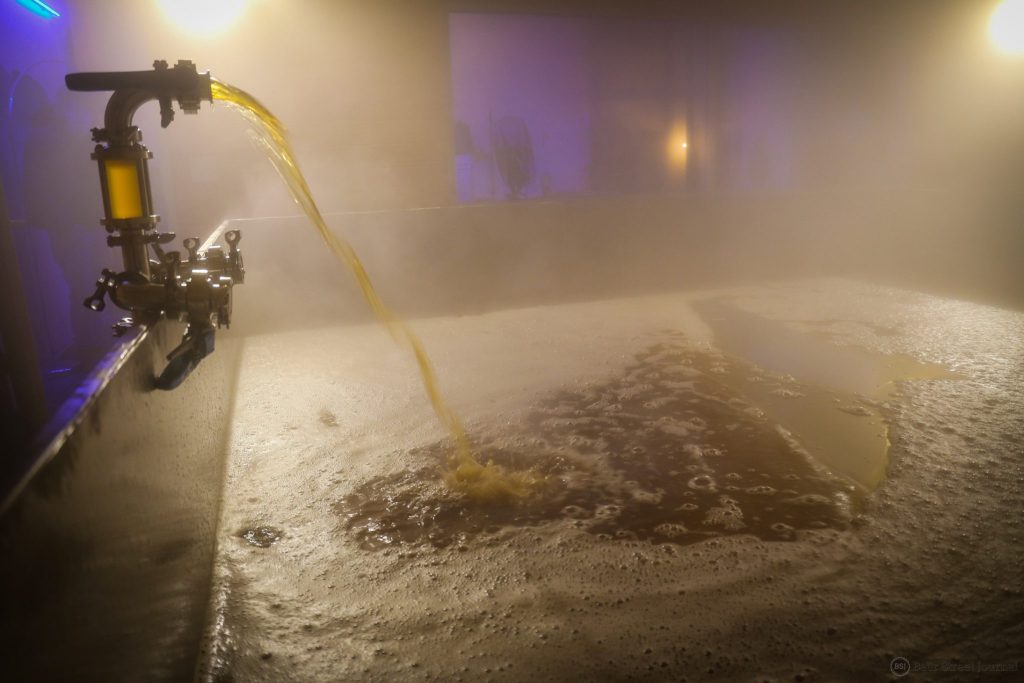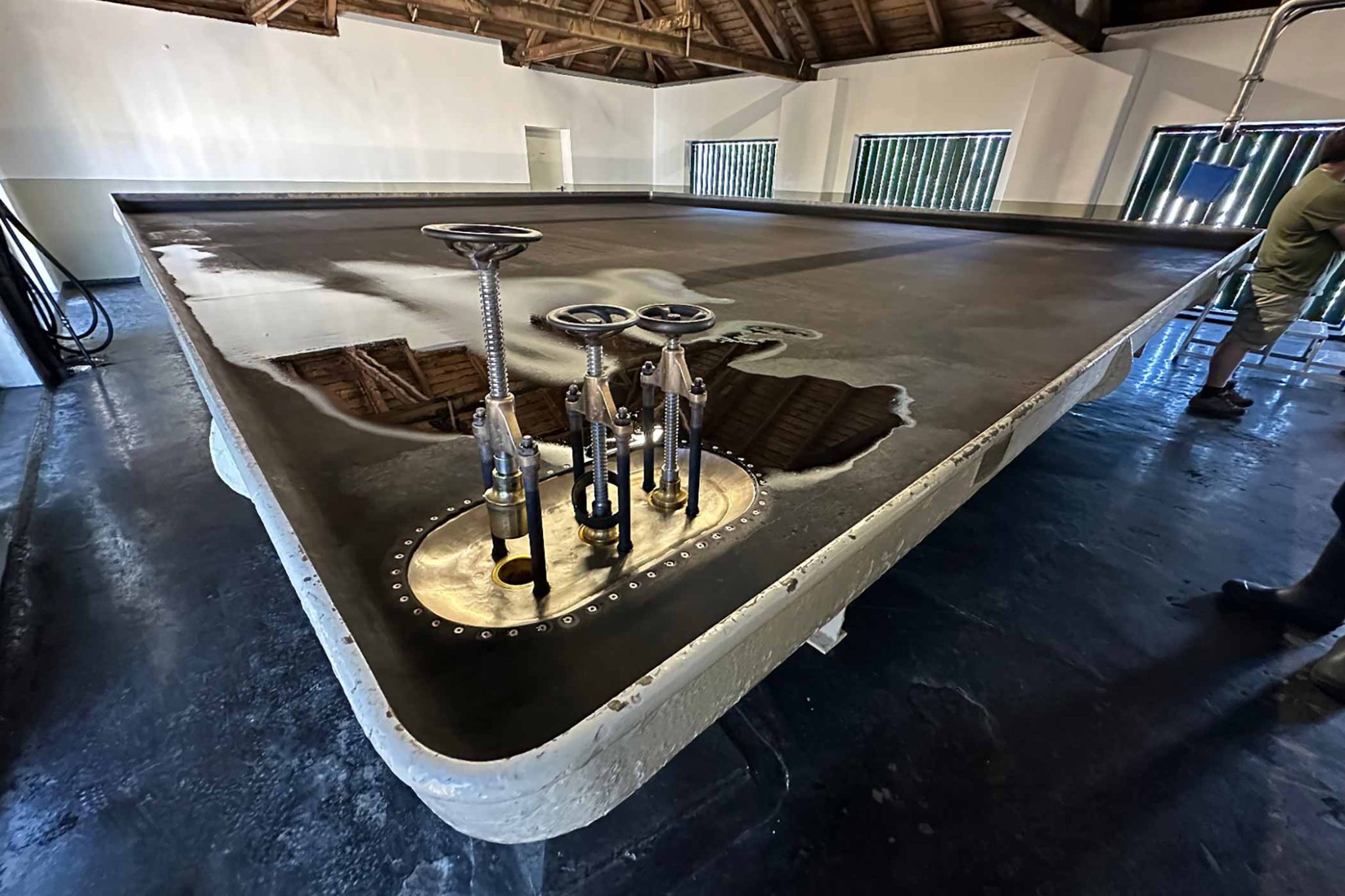導入

Coolship brewing represents a fascinating method in the world of craft beer, known for its role in creating beers with distinctive and complex flavors. This traditional brewing technique, which involves cooling wort in an open vessel, allows wild yeast and bacteria from the environment to ferment the beer spontaneously. This blog will delve into the impact of coolship brewing on modern beer flavors, exploring its historical background, brewing process, and influence on today’s craft beer scene.
The Historical Roots of Coolship Brewing
Origins and Development
Coolship brewing has its roots in Belgium, where it was traditionally used to cool wort before fermentation. This process, using a shallow, open vessel called a coolship, allows the hot wort to interact with ambient air, introducing wild yeast and bacteria essential for spontaneous fermentation. Classic Belgian beers such as Lambic and Gueuze were originally produced using this technique, contributing to their unique and complex flavor profiles.
Decline and Revival
The rise of modern brewing technology led to a decline in traditional coolship methods. However, the craft beer movement of the late 20th century saw a resurgence of interest in these age-old techniques. Breweries around the world began to revisit coolship brewing, seeking to recreate and innovate upon traditional styles. This revival has introduced a new generation to the artistry and unpredictability of coolship-brewed beers.
の Coolship Brewing プロセス
Key Steps in Coolship Brewing
- Boiling the Wort: The process starts with boiling wort extracted from malted grains. This sterilizes the wort and extracts essential flavors from the grains.
- Transferring to the Coolship: After boiling, the hot wort is transferred to a coolship—an open, shallow vessel designed to maximize surface area exposure to the air.
- Cooling and Exposure: The wort is left in the coolship to cool naturally. During this time, it is exposed to ambient air, allowing wild yeast and bacteria to inoculate the wort and initiate fermentation.
- 発酵: Once cooled, the wort is transferred to fermentation vessels where it continues to ferment with the wild yeast and bacteria. This process can last several months to several years.
- Aging and Blending: The beer is aged and may be blended with other batches to develop its final flavor profile. This aging process is crucial for achieving the desired complexity and character.
利点と課題
利点:
- Complex Flavors: The exposure to wild yeast and bacteria creates unique and nuanced flavors.
- Unique Characteristics: Each batch is influenced by environmental factors, resulting in distinctive characteristics.
課題:
- Inconsistency: The use of wild yeast and bacteria can lead to inconsistent results, making it difficult to achieve uniformity.
- Extended Production Time: The fermentation and aging process is longer compared to traditional brewing methods.
Popular Coolship Beer Styles
Coolship brewing has led to the creation of several unique beer styles. Here are some notable examples:
Lambic
Lambic is a traditional Belgian style known for its spontaneous fermentation with wild yeast and bacteria. It typically features sour and fruity flavors and is often aged for several years to develop its complexity. Brouwerij Boon in Belgium is renowned for its Lambic beers, maintaining traditional brewing practices while producing high-quality, authentic Lambics.
Gueuze
Gueuze is a blend of young and old Lambics, which is carbonated and aged further in the bottle. It is recognized for its complex, effervescent, and slightly sour profile. Cantillon Brewery, another esteemed Belgian brewery, is celebrated for its Gueuze, crafted with a dedication to traditional methods and quality.
Flanders Red Ale
Flanders Red Ale is a Belgian style that undergoes mixed fermentation, resulting in a sour, malty beer with notes of dark fruit and oak. Brouwerij Het Anker in Belgium is known for its Flanders Red Ale, combining historical techniques with modern expertise to produce rich and flavorful ales.
American Wild Ale
American Wild Ale represents a modern take on coolship brewing techniques, with brewers experimenting with various wild yeast strains and ingredients. The Bruery in California is a prominent example of a brewery embracing coolship methods to create innovative American Wild Ales with unique and complex flavors.
の影響 Coolship Brewing on Modern Beer Flavors
Innovative Flavor Profiles
Coolship brewing has profoundly influenced modern beer flavors by encouraging innovation and experimentation. Brewers have embraced the unique characteristics of coolship beers to create new and exciting flavor profiles, including:
- Sour and Tart Flavors: The wild yeast and bacteria contribute to the sour and tart qualities increasingly popular in the craft beer scene.
- Complex Aromas: Coolship fermentation imparts complex aromas, such as fruity, earthy, and floral notes.
- Experimental Ingredients: Brewers use coolship techniques to experiment with fruits, spices, and herbs, leading to diverse and unique flavors.
Influence on Brewing Techniques
The resurgence of coolship brewing has inspired a broader exploration of brewing techniques. Many modern breweries have adopted elements of coolship brewing, such as open fermentation and wild yeast cultivation, in their practices. This influence has contributed to the craft beer industry’s growth and diversity.
表: 比較 Coolship Beer Styles
| Style | 特徴 | フレーバープロフィール | Aging Time |
|---|---|---|---|
| Lambic | Spontaneously fermented with wild yeast | Sour, fruity, earthy | Several years |
| Gueuze | Blend of young and old Lambics | Complex, effervescent, slightly sour | Several months to years |
| Flanders Red Ale | Mixed fermentation with wild yeast and bacteria | Sour, malty, dark fruit, oak | Several months to years |
| American Wild Ale | Experimental coolship beers with various ingredients | Tart, fruity, complex | Several months to years |
Case Studies: Pioneering Breweries

Brouwerij Boon: Preserving Tradition
Based in Belgium, Brouwerij Boon has been a pioneer in traditional Lambic brewing. Their coolship process is integral to their production, maintaining the authenticity of their Lambics and Gueuze. Their commitment to preserving traditional brewing methods while achieving consistent quality has earned them a respected place in the industry.
Cantillon Brewery: Innovative Classics
Cantillon Brewery in Brussels is renowned for its innovative approach to traditional Belgian beers. Their coolship-brewed Gueuze and Lambics exemplify the brewery’s dedication to maintaining historical techniques while exploring new flavor possibilities. Cantillon’s beers are celebrated for their depth and complexity.
The Bruery: Pioneering American Wild Ales
The Bruery, located in California, is known for its experimental approach to coolship brewing. By incorporating various wild yeast strains and ingredients, they create American Wild Ales with unique flavor profiles. Their innovative use of coolship techniques has set new standards in the craft beer industry.
結論
Coolship brewing has had a transformative impact on modern beer flavors, blending traditional techniques with contemporary innovation. By leveraging wild yeast and bacteria, brewers create beers with unparalleled complexity and character. The resurgence of coolship brewing highlights the ongoing evolution of the craft beer industry and the endless opportunities for flavor exploration.
As more breweries embrace coolship techniques and experiment with new approaches, we can look forward to even more exciting developments in the world of beer. Whether you are a seasoned enthusiast or new to craft beer, coolship-brewed beers offer a captivating journey through the rich history and creativity of brewing.
よくある質問
Q: クールシップ醸造所?
A:Coolship brewing is a method where hot wort is cooled in an open vessel, allowing wild yeast and bacteria from the environment to ferment the beer spontaneously. This process creates beers with unique and complex flavors.
Q:What types of beers are typically brewed using coolship methods?
A:Common coolship beers include Lambic, Gueuze, Flanders Red Ale, and American Wild Ale. These styles are known for their sour and complex flavors resulting from spontaneous fermentation.
Q:どのように クールシップ醸造所 differ from other brewing methods?
A:Coolship brewing relies on wild yeast and bacteria for fermentation, whereas other methods use controlled yeast strains. This leads to distinctive and varied flavor profiles that are not easily replicated.
Q:Are coolship beers more difficult to brew?
A:Yes, coolship brewing can be more challenging due to its reliance on wild yeast and bacteria, which can lead to inconsistent results. Additionally, the fermentation and aging process is longer compared to traditional methods.
Q:Can I find coolship-brewed beers outside of Belgium?
A:Yes, many breweries outside of Belgium, such as The Bruery in the United States, use coolship techniques to produce innovative beers. These breweries experiment with different ingredients and styles, contributing to a diverse range of coolship-brewed beers available globally.

